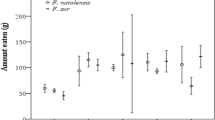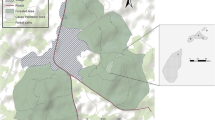Abstract
The Montpellier region (Mediterranean France) offers 65 native taxa with fleshy fruits whose seeds are dispersed mainly by bird species. Birds also remove the fleshy fruits of non-native plant species, cultivated ones (e.g. Vitis vinifera ssp. vinifera), weeds (e.g. Phytolacca americana), garden shrubs (e.g. Pyracantha coccinea, Ligustrum ovalifolium). We report that 19 non-native plant species are dispersed by 16 bird species. Grapes constitute a very importand food item for migrating and wintering thrushes (mainly Turdus philomelos and T. iliacus) and are as important as fruits of wild plants (Juniperus sp. pl.) in their diet. Pyracantha coccinea, and subsidiarily other garden shrubs (e.g. Cotoneaster sp. pl., Ligustrum ovalifolium) attract small passerines, predominantly Blackcaps (Sylvia atricapilla), during winter and at the beginning of spring.
The diet of the Blackcap, a nearly exclusive frugivorous bird in autumn and winter, shows a significant trend from native to introduced fruits from summer to early spring, as the availability in native fruits progressively becomes more scarce. At the same time their populations are concentrated in villages and suburban gardens where crops of ornamental plant species persist for a long time. On the other hand, the diet of the European Robin (Erithacus rubecula) which is less dependent on fruits, does not show the same shift and their populations do not move to more anthropic areas.
We suggest that the abundant crops provided by cultivated and ornamental plants may change the migrating and wintering behaviour of the fruit dependent bird species, allowing some of them to winter in more northern or different regions than they formerly used to do.
Only 6 out of 19 listed plant-species can be considered as naturalized, but no one is actually invasive. We think that this absence of invasion success must be linked with several regional features, i.e. (1) climatic stresses (frost and drought), (2) edaphic constraints (calcareous soils), (3) landscape composition (predominance of wooded areas) and (4) richness in native fleshy- fruited species which offer large crops and a wide spectrum of availability, fruit types and pulp chemical contents.
Access this chapter
Tax calculation will be finalised at checkout
Purchases are for personal use only
Preview
Unable to display preview. Download preview PDF.
Similar content being viewed by others
References
Amor R.L. 1974. Ecology and control of blackberry (Rubus fruticosus L. agg.). II. Reproduction. Weed Research 14: 231–238.
Blondel J. 1969. Synécologie des Passereaux résidents et migrateurs dans le Midi méditerranéen français. C.R.D.P., Marseille, 239 p.
Brunner H., Harris R.V. & Amor R.L. 1976. A note on the dispersal of seeds of blackberry (Rubus procerus RJ. Muell.) by foxes and emus. Weed Research 16: 171–173.
Daget R 1977. Le bioclimat méditerranéen: analyse des formes climatiques par le système d’Emberger. Vegetatio 34: 87–103.
Debussche M. 1988. La diversité morphologique des fruits charnus en Languedoc méditerranéen: importance de la plante, de sa saison de fructification, de sa distribution géographique et rôle des disséminateurs. Acta Oecologica, Oecol. Gener. 9: 37–52.
Debussche M., Cortez J. & Rimbault I. 1987. Variations in fleshy fruit composition in the Mediterranean region: the importance of ripening season, life-form, fruit type and geographical distribution. Oikos 49: 244–252.
Debussche M., Escarré J. & Lepart J. 1982. Ornithochory and plant succession in Mediterranean abandoned orchards. Vegetatio 48: 255–266.
Debussche M. & Isenmann P. 1983. La consommation de fruits chez quelques espèces de Fauvettes méditerranéennes (Sylvia melanocephala, S. cantillans, S. hortensis, S. undata). Alauda 51: 302–308.
Debussche M. & Isenmann P. 1984. Origine et nomadisme des Fauvettes à tête noire (Sylvia atricapillà) hivernant en zone méditerranéenne française. L’Oiseau et R.F.O. 54: 101–107.
Debussche M. & Isenmann P. 1985a. Frugivory of transient and wintering European robins Erithacus rubecula in a Mediterranean region and its relationship with ornithochory. Holarctic Ecology 8: 157–163.
Debussche M. & Isenmann P. 1985b. Le régime alimentaire de la Grive musicienne (Turdus philomelos) en automne et en hiver dans les garrigues de Montpellier (France méditerranéenne) et ses relations avec l’ornithochorie. Rev. Ecol. (Terre Vie) 40: 379–388.
Debussche M. & Isenmann P. 1985c. An example of Redwing diet in a Mediterranean wintering area. Bird Study 32: 152–153.
Debussche M. & Isenmann P. 1986. L’ornithochorie dans les garrigues languedociennes: les petits passereaux disséminateurs d’importance secondaire. L’Oiseau et R.F.O. 56: 71–76.
Debussche M. & Isenmann P. 1989. Fleshy fruit characters and the choices of bird and mammal dispersers in a Mediterranean region. Oikos 56.
Debussche M., Lepart J. & Molina J. 1985. La dissémination des plantes à fruits charnus par les oiseaux: rôle de la structure de la végétation et impact sur la succession en région méditerranéenne. Acta Oecologica, Oecol. Gener. 6: 65–80.
Debussche M., Rambal S., & Lepart J. 1987. Les changements de l’occupation des terres en région méditerranéenne humide: évaluation des conséquences hydrologiques. Acta Oecologica, Oecol. Applic. 8: 317–332.
Escarré J., Houssard C., Debussche M. & Lepart J. 1983. Evolution de la végétation et du sol après abandon cultural en région méditerranéenne: étude de succession dans les Garrigues du Montpelliérais (France). Acta Oecologica, Oecol. Plant. 4: 221–239.
Finlayson J.C. 1980. The recurrence in winter quarters at Gibraltar of some scrub passerines. Ringing and Migration 3: 32–34.
Fouarge J. 1980. Le point sur les cas d’hivernage de la Fauvette à tête noire (Sylvia atricapillà) en Belgique. Aves 17: 17–27.
Fournier, P. 1977. Les quatre flores de la France, Lechevalier (éd.), Paris, 2e éd., 1106 p.
Glyphis J.P., Milton S.J. & Siegfried W.R. 1981. Dispersal of Acacia cyclops by Birds. Oecologia (Berl.) 48: 138–141.
Hardy E. 1978. Winter foods of Blackcaps in Britain. Bird Study 25: 60–61.
Herrera C.M. 1981. Are tropical fruits more rewarding to dispersers than temperate ones? Am. Nat. 118: 896–907.
Herrera C.M. 1982. Seasonal variation in the quality of fruits and diffuse coevolution between plants and avian dispersers. Ecology 63: 773–785.
Herrera C.M. 1984. A study of avian frugivores, bird-dispersed plants, and their interaction in Mediterranean scrublands. Ecol. Monogr. 54: 1–23.
Jordano P. 1984. Relaciones entre plantas y aves frugívoras en el matorral Mediterráneo del área de Doñana. Thesis Univ. Sevilla, 284 p.
Leach I.H. 1981. Wintering Blackcaps in Britain and Ireland. Bird Study 28: 5–14.
Morel G. & Roux F. 1966. Les migrateurs paléarctiques du Sénégal. II. Terre et Vie 20: 143–176.
Patterson D.T. 1976. The history and distribution of 5 exotic weeds in North Carolina U.S.A. Castanea 41: 177–180.
Ridley H.N. 1930. The dispersal of plants throughout the world. Reeve & Co., Ashford, Great Britain, 744 p.
Rodriguez de los Santos M., Cuadrado M. & Arjona S. 1986. Variation in the abundance of Blackcaps (Sylvia atricapillà) wintering in an Olive (Olea europaea) orchard in Southern Spain. Bird Study 23: 81–86.
Snow B. & Snow D. 1988. Birds and berries. A study of an ecological interaction. T. & A.D. Poyser, Calton, England, 268 p.
Sultana J. 1972. The Blackcap, was it overlooked? II-Merill 7: 13.
Tejero E., Camacho I. & Soler M. 1984. La alimentación del Zorzal común (Turdus philomelos) en olivares de la provincia de Jaén (otoño-invierno). Anales INI A: Serie forestal 8: 9-32.
Thellung A. 1908-1910. La flore adventice de Montpellier. Mém. Soc. Nat. Sc. Nat. Math. Cherbourg 37: 58–727.
Thomas A.S. 1960. Changes in vegetation since the advent of myxomatosis. J. Ecol. 48: 287–306.
Thomas A.S. 1963. Further changes in vegetation since the advent of myxomatosis. J. Ecol. 51: 151–186.
Turcek F. 1961. Ökologische Beziehungen der Vögel und Gehölze, Vydavatel’stvo Slovensky Akademie vied, Bratislava, 330 p.
Tutin T.G., Heywood V.H., Burges N.A., Moore D.M., Valentine D.H., Walters S.M. & Webb D.A. 1964–1980. Flora Europaea. Cambridge University Press, Cambridge.
Editor information
Rights and permissions
Copyright information
© 1990 Kluwer Academic Publishers, Dordrecht
About this chapter
Cite this chapter
Debussche, M., Isenmann, P. (1990). Introduced and cultivated fleshy-fruited plants: consequences of a mutualistic Mediterranean plant-bird system. In: di Castri, F., Hansen, A.J., Debussche, M. (eds) Biological Invasions in Europe and the Mediterranean Basin. Monographiae Biologicae, vol 65. Springer, Dordrecht. https://doi.org/10.1007/978-94-009-1876-4_26
Download citation
DOI: https://doi.org/10.1007/978-94-009-1876-4_26
Publisher Name: Springer, Dordrecht
Print ISBN: 978-94-010-7337-0
Online ISBN: 978-94-009-1876-4
eBook Packages: Springer Book Archive




